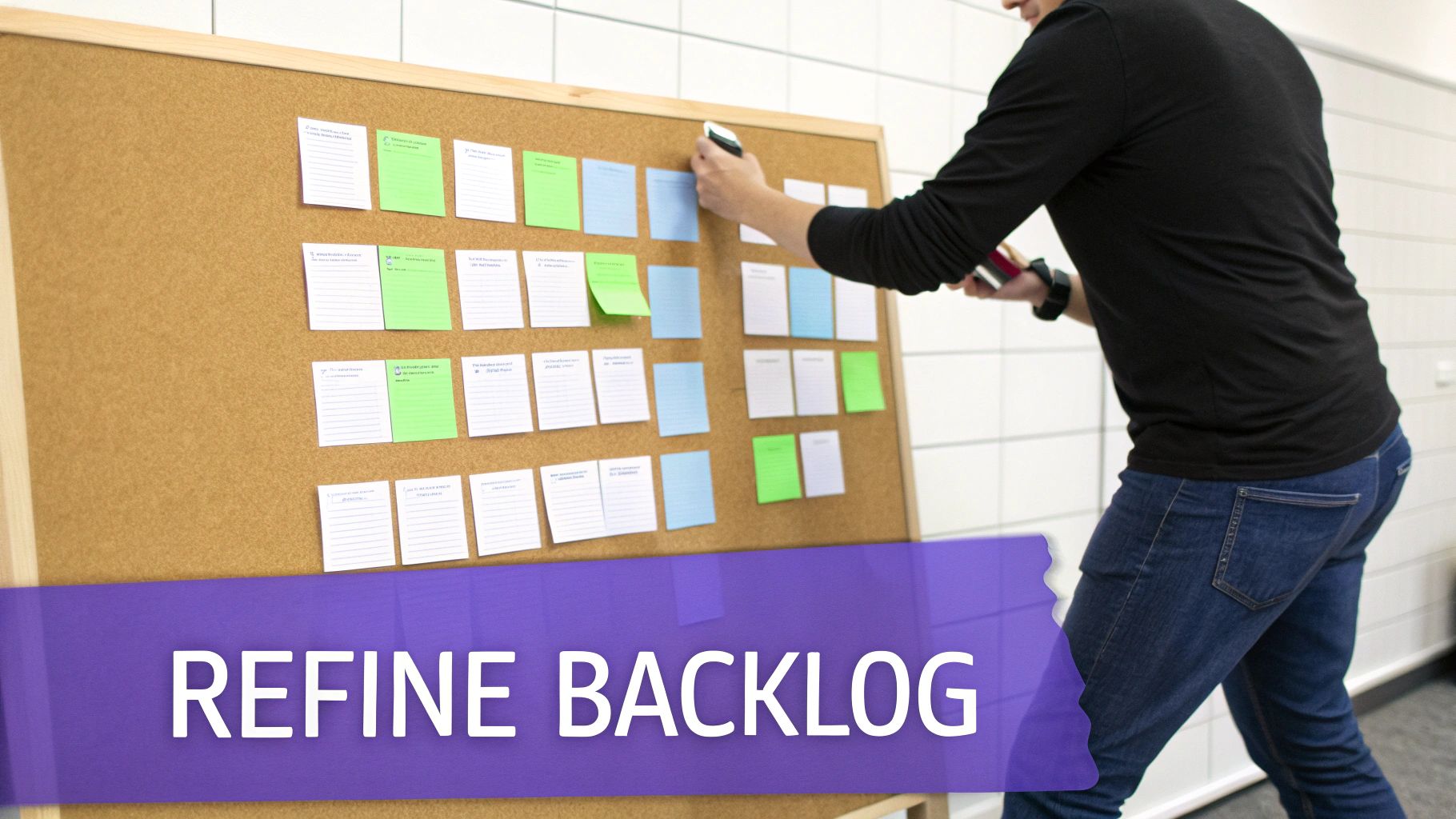Sprint planning for remote and hybrid teams can feel like navigating a maze blindfolded. Without a clear process, distributed teams often face misaligned expectations, unclear priorities, and mounting pressure that leads to burnout. The problem isn't a lack of effort; it's the absence of a structured framework that fosters collaboration and predictability. Effective sprint planning is more than just assigning tasks from a backlog. It’s about creating a shared understanding, committing to achievable goals, and defining a clear path to delivering value, which are all key components of successful remote workforce management strategies.
This guide cuts through the noise. We've compiled eight proven sprint planning best practices designed to bring order to the chaos and empower your remote team. From accurately estimating effort with Planning Poker to defining clear Sprint Goals and establishing a rock-solid Definition of Done, these techniques provide the structure needed to succeed. Forget vague advice and generic tips. Here, you'll find actionable insights and practical steps to transform your planning sessions from dreaded obligations into powerful, collaborative events. By implementing these strategies, your team will build better products, hit deadlines consistently, and thrive in any work environment.
1. User Story Mapping
Traditional backlogs often become a flat, one-dimensional list of tasks that lack context. User story mapping is one of the most effective sprint planning best practices because it transforms that flat list into a dynamic, two-dimensional map. This collaborative technique, popularized by Jeff Patton, helps teams visualize the entire user journey from start to finish.
The process creates a visual representation of a user's workflow. The horizontal axis outlines the main activities or steps a user takes (the "narrative flow"), while the vertical axis details the specific user stories related to each step, organized by priority. This structure ensures everyone understands how individual tasks fit into the bigger picture, preventing teams from losing sight of the user's ultimate goal.
Why It Works for Sprint Planning
Story mapping excels at building a shared understanding across the entire team, including developers, designers, and stakeholders. It makes it easier to identify gaps, dependencies, and priorities. For example, e-commerce giants like Shopify use it to map out the entire customer checkout experience, ensuring no critical step is missed. Similarly, Microsoft Teams employs this method to organize complex collaboration features into a coherent user journey.
This visual approach is especially powerful for remote and hybrid teams. Using digital whiteboarding tools like Miro or Mural, everyone can contribute simultaneously, creating a single source of truth that guides sprint planning.
How to Implement User Story Mapping
- Build the Backbone: Start by identifying the high-level user activities that form the core of the user journey. These become the columns of your map.
- Flesh out the Details: Under each activity, brainstorm and place the user stories that enable it. Arrange them vertically by priority or complexity.
- Slice for Sprints: Once the map is built, draw horizontal lines to group stories into releases or sprints. This makes it clear what can be delivered in each iteration to provide incremental value.
For a deeper dive into organizing this kind of collaborative session, check out these tips for planning effective remote workshops.
2. Planning Poker (Estimation)
Estimating work accurately can be one of the most challenging parts of sprint planning, often leading to debate or mismatched expectations. Planning Poker is one of the most widely adopted sprint planning best practices because it turns estimation into a collaborative and consensus-driven activity. This gamified technique, popularized by Mike Cohn, ensures all team members contribute their perspective on the effort required for a user story.

The process involves team members using numbered cards (typically following the Fibonacci sequence) to vote on their estimate for a task. Everyone reveals their card simultaneously, which crucially prevents the "anchoring bias" where the first number spoken influences the rest of the group. This simultaneous reveal encourages independent thinking and surfaces diverse viewpoints.
Why It Works for Sprint Planning
Planning Poker is effective because it fosters discussion and uncovers hidden complexities or assumptions. When estimates vary widely, the team is prompted to discuss why. For example, a senior developer might estimate a story as a "3," while a junior developer sees it as an "8." This discrepancy initiates a valuable conversation about potential technical hurdles or overlooked requirements.
This technique is a standard in many agile organizations. Atlassian recommends it for Jira-based workflows, and many Google teams use variants to align on complexity. It's particularly useful for remote teams using digital tools like Miro or specialized Planning Poker apps, which replicate the in-person experience seamlessly.
How to Implement Planning Poker
- Introduce the Story: The product owner or facilitator presents a user story and clarifies any questions the team has.
- Estimate Privately: Each team member privately selects a card representing their estimate of the effort involved. The Fibonacci sequence (1, 2, 3, 5, 8, 13…) is often used because it reflects the increasing uncertainty in larger estimates.
- Reveal and Discuss: Everyone reveals their card at the same time. If estimates are close, the team agrees on a final number. If there are significant outliers, the highest and lowest estimators explain their reasoning.
- Re-estimate Until Consensus: The team repeats the estimation process until a consensus is reached. This process builds a shared understanding of the task and strengthens team alignment.
For a deeper look into aligning your team, explore these proven consensus-building techniques for remote teams.
3. Sprint Goal Definition
A backlog full of tasks can easily make a team feel like they are just checking off a list without a clear purpose. Sprint Goal Definition is one of the most fundamental sprint planning best practices because it provides that purpose. It's the practice of setting a single, clear, and inspiring objective for the sprint that unites the team around a common outcome.
This goal articulates the business value the team aims to deliver by the end of the sprint, shifting the focus from "what we are building" to "why we are building it." Coined by Scrum co-creator Ken Schwaber, this concept ensures the team understands the collective value of their work, empowering them to make autonomous decisions to achieve the objective.

Why It Works for Sprint Planning
A well-defined sprint goal provides focus and flexibility. It guides the team during daily stand-ups and helps them negotiate scope if they encounter unexpected roadblocks, all without losing sight of the sprint's purpose. For example, Netflix structures sprints around goals like "Improve the personalized content recommendation algorithm by 5%," rather than just listing technical tasks. Similarly, Salesforce uses sprint goals to align its globally distributed development teams on a shared mission for each iteration.
This practice is crucial for remote and hybrid teams, as the sprint goal acts as a north star, keeping everyone aligned even when they aren't in the same room. It fosters a sense of shared commitment and makes the team's progress more tangible to stakeholders.
How to Implement Sprint Goal Definition
- Collaborate on the 'Why': The Product Owner should come to sprint planning with a business objective, and the entire team collaborates to craft a concise and measurable goal.
- Use a Clear Format: Write the goal in simple, user-centric language. A great format is: "Enable [users] to [do something], so that they can [achieve a benefit]."
- Keep It Visible: Display the sprint goal prominently in your team's digital workspace, like on a Jira dashboard or a shared Slack channel. Reference it daily to keep it top of mind.
- Align with a Larger Vision: Ensure each sprint goal is a stepping stone toward a larger product roadmap objective or a quarterly OKR.
For a comprehensive guide on this foundational Scrum element, Scrum.org provides excellent resources on crafting effective sprint goals.
4. Capacity-Based Planning
Overcommitting is one of the fastest ways to burn out a team and derail a sprint. Capacity-based planning is one of the most crucial sprint planning best practices because it grounds sprint commitments in reality. Instead of relying on guesswork, this technique involves calculating the team’s actual available work hours for an upcoming sprint.
This approach requires the team to account for all commitments that take time away from sprint tasks, including holidays, paid time off, company-wide meetings, and even context-switching. By subtracting these non-project hours from the total available time, teams arrive at a realistic capacity figure, ensuring they only pull in a manageable amount of work.
Why It Works for Sprint Planning
Capacity-based planning fosters a sustainable pace and builds trust by setting achievable goals. It prevents the all-too-common cycle of sprint failures caused by unrealistic expectations. For example, Spotify uses this to manage the differing velocities of its autonomous squads, while Deloitte implements it across consulting teams to balance project work with professional development.
This data-driven approach is especially valuable for remote and hybrid teams where individual schedules can vary significantly. By transparently mapping out everyone's availability, the team can commit to a sprint backlog with confidence, knowing they have the collective bandwidth to succeed.
How to Implement Capacity-Based Planning
- Calculate Your Baseline: Determine your team's historical velocity by averaging story points completed over the last 3 to 6 sprints. This provides a data-backed starting point.
- Account for All Commitments: Create a shared calendar or spreadsheet detailing all planned time off, holidays, recurring meetings, and other non-sprint work for each team member. Subtract these hours from the total.
- Reserve a Buffer: Set aside 10-20% of your total capacity for unplanned work, urgent bugs, or unexpected issues. This buffer prevents a single surprise from derailing the entire sprint.
- Involve the Team: Make capacity planning a collaborative exercise. When team members are involved in setting their own capacity, they are more invested in the sprint goal.
To integrate this into your broader workflow, you can learn more about how capacity fits into other project management best practices.
5. Backlog Refinement and Grooming
Sprint planning can quickly derail if the backlog is a messy, unprioritized list of vague ideas. Backlog refinement, often called grooming, is one of the most crucial sprint planning best practices for preventing this chaos. It's the ongoing process of adding detail, estimates, and order to items in the product backlog, ensuring stories are ready for development before the sprint even begins.
This practice transforms raw concepts into actionable work items. By continuously refining the backlog, teams ensure that the highest-priority stories are well-understood and meet the team's Definition of Ready. This proactive approach eliminates ambiguity and reduces time spent on clarification during the sprint planning meeting itself, making the session far more efficient and focused.

Why It Works for Sprint Planning
Effective refinement creates a buffer of well-prepared work, allowing for smoother and more predictable sprints. It’s a core practice at companies like Atlassian, where teams dedicate a portion of their sprint capacity to these activities to maintain momentum. Similarly, Shopify uses structured refinement sessions to prepare stories for their two-week sprints, ensuring clarity and alignment across their product teams.
This collaborative process brings together the product owner, developers, and QA to discuss requirements, dependencies, and potential technical hurdles ahead of time. This shared understanding minimizes surprises during development and helps produce more accurate sprint forecasts. For remote and hybrid teams, scheduled refinement sessions are essential for maintaining alignment when informal desk-side chats aren't possible.
How to Implement Backlog Refinement
- Schedule It Consistently: Dedicate a specific time for refinement during each sprint. A common practice is to hold a 1-2 hour session to prepare stories for the next one or two sprints.
- Use a Readiness Checklist: Ensure every story has clear acceptance criteria, a user-facing description, and an initial estimate before it's considered "ready" for a sprint. This creates a consistent quality bar.
- Focus on the Top: Concentrate refinement efforts on the highest-priority items in the backlog. There's no need to refine stories that are months away from being implemented.
- Investigate Unknowns: If a story has significant technical uncertainty, create a "technical spike" or research task to investigate it before committing the story to a sprint.
For more on organizing your backlog, explore these powerful prioritization techniques for product managers.
6. Definition of Ready (DoR) and Definition of Done (DoD)
Ambiguity is a major obstacle to effective sprints, leading to rework and missed goals. Establishing a clear Definition of Ready (DoR) and Definition of Done (DoD) is one of the most fundamental sprint planning best practices for eliminating confusion. These two sets of criteria act as gatekeepers, ensuring work items are properly prepared before a sprint begins and fully completed before they are considered finished.
The Definition of Ready is a checklist that a user story must meet before the team can commit to it in sprint planning. Conversely, the Definition of Done is a checklist that confirms a story is truly complete, meeting all quality and operational standards. Together, they create a shared understanding of what "ready" and "done" mean, preventing misunderstandings and ensuring a consistent level of quality.
Why It Works for Sprint Planning
These definitions create explicit agreements within the team, reducing debates during sprint planning and reviews. The DoR ensures the team only pulls in work that is well-understood and actionable, improving forecast accuracy. The DoD guarantees that every completed item is genuinely shippable, preventing technical debt. For instance, Google’s DoD often includes rigorous code reviews and documentation updates, while financial institutions add compliance verification to their checklists, ensuring no critical step is skipped.
This practice is invaluable for remote and hybrid teams, where clear, documented standards are essential for asynchronous collaboration. When everyone knows the entry and exit criteria for work, the team can operate with more autonomy and less friction.
How to Implement DoR and DoD
- Co-create the Checklists: Work with your entire team during a retrospective to define your initial DoR and DoD. This ensures collective ownership and buy-in.
- Keep Them Visible and Concise: Post your DoR and DoD in a shared digital space like Confluence or your project management tool. Aim for 5-7 clear, actionable items for each.
- Example DoR: User story is written, Acceptance criteria are defined, Dependencies are identified, Design mockups are attached.
- Example DoD: Code is peer-reviewed, All unit and integration tests are passing, QA testing is complete, Documentation is updated.
- Review and Adapt: Revisit your definitions quarterly or whenever the team identifies recurring issues. Your DoR and DoD should evolve with your team’s processes and maturity.
To learn more about the principles behind these practices, explore the foundational work of Ken Schwaber and Mike Cohn's resources at Mountain Goat Software.
7. Time-Boxing and Structured Sprint Planning Meetings
Sprint planning can easily derail into endless debates, scope creep, and analysis paralysis. Time-boxing is one of the most fundamental sprint planning best practices because it imposes strict, predetermined time limits on each activity. This technique, core to the Scrum framework, forces the team to stay focused, make decisions efficiently, and respect everyone's time, which is especially critical in remote settings.
The principle is simple: allocate a fixed duration for each part of the meeting. The Scrum Guide suggests a maximum of eight hours for a one-month sprint, which scales down proportionally. For a typical two-week sprint, this means a four-hour planning session. By structuring the meeting into smaller, time-boxed segments for goal setting, story selection, and task breakdown, teams prevent any single topic from consuming the entire schedule.
Why It Works for Sprint Planning
Time-boxing creates a sense of urgency that drives progress and encourages concise communication. It helps teams prioritize what truly matters and move on, rather than getting stuck on minor details. For example, Netflix is known for its highly efficient 90-minute sprint planning meetings, which are broken into even smaller time-boxed sections to maintain momentum. Similarly, Atlassian uses skilled facilitators to enforce these time constraints, ensuring their globally distributed teams stay aligned and productive.
This structured approach is invaluable for remote and hybrid teams, where meeting fatigue is a real concern. A visible timer and a clear agenda ensure that everyone knows what to expect and what is expected of them, making the entire process more predictable and less draining.
How to Implement Time-Boxing
- Set the Overall Time-Box: Adhere to the Scrum recommendation of two hours of planning for each week of the sprint. For a two-week sprint, block off a maximum of four hours.
- Divide and Conquer: Break the meeting into smaller, focused segments. For a four-hour session, you might allocate one hour for defining the sprint goal, two hours for story selection, and one hour for task breakdown.
- Use a Visible Timer: Keep an on-screen timer or a physical one visible to all participants. This creates shared accountability for sticking to the schedule.
- Prepare a Clear Agenda: A well-defined agenda, distributed in advance, is crucial for an effective time-boxed meeting. For a great starting point, check out this simple meeting agenda template.
8. Risk Assessment and Dependency Mapping
Ignoring potential roadblocks is a surefire way to derail a sprint. Risk assessment and dependency mapping is one of the most critical sprint planning best practices because it forces teams to proactively identify and plan for obstacles before they arise. This forward-looking process involves flagging potential blockers, technical uncertainties, and cross-team dependencies that could jeopardize the sprint goal.
This practice transforms sprint planning from a purely optimistic exercise into a strategic one. By surfacing potential problems early, teams can create contingency plans, allocate resources for uncertainty, and coordinate with other teams or external partners. The goal is to eliminate mid-sprint surprises that cause delays and frustration, ensuring a smoother, more predictable iteration.
Why It Works for Sprint Planning
This proactive approach builds resilience and predictability into the sprint. For instance, Uber’s engineering organization maps dependencies across hundreds of microservices and teams to coordinate large-scale feature releases, preventing integration failures. Similarly, enterprise teams in highly regulated industries like banking use risk assessment to ensure new features meet strict compliance and security standards before any code is written.
For remote and distributed teams, this practice is even more crucial. It helps surface coordination needs related to time-zone differences and communication gaps. Documenting owners and escalation paths for each dependency ensures that when a blocker does appear, everyone knows who to contact and how to resolve it quickly.
How to Implement Risk Assessment and Dependency Mapping
- Create a Dependency Matrix: During planning, identify and categorize dependencies: Internal (e.g., team knowledge gaps), External (e.g., third-party APIs), and Organizational (e.g., stakeholder approvals).
- Assess Probability and Impact: For each identified risk or dependency, evaluate its likelihood (high/medium/low) and potential impact on the sprint goal (high/medium/low). Focus your attention on high-probability, high-impact items.
- Plan for High-Risk Items: For technically uncertain tasks, create "spike" stories to investigate and reduce the unknown. For critical dependencies, schedule pre-sprint coordination meetings with the relevant teams.
- Document and Track: Use your project management tool to log all identified risks and dependencies. Assign owners and use status indicators (e.g., "Blocked," "In Progress") to maintain visibility throughout the sprint.
For a deeper understanding of managing risk in Agile projects, the Disciplined Agile (DA) toolkit by the Project Management Institute offers comprehensive guidance.
8-Point Sprint Planning Best Practices Comparison
| Technique | Implementation complexity 🔄 | Resource / Effort ⚡ | Expected outcomes 📊 | Ideal use cases 💡 | Key advantages ⭐ |
|---|---|---|---|---|---|
| User Story Mapping | Moderate–High: workshop setup and 2D mapping; grows with scope | Cross-functional time, facilitator, digital board or sticky notes | Visualized user journey, prioritized MVP, early dependency visibility | Early discovery, release planning, mapping complex workflows | Contextual prioritization; stakeholder alignment; dependency identification |
| Planning Poker (Estimation) | Low–Moderate: simple rules but needs calibration and facilitation | Minimal tools (cards/apps), team time per story | Consensus-based effort estimates; surfaced assumptions and risks | Sprint estimation, team calibration, small–medium backlogs | Reduces anchoring; improves estimate accuracy; team engagement |
| Sprint Goal Definition | Low: concise statement creation; harder for multi-team work | Product owner + stakeholder time; minimal tooling | Clear focus and decision guidance; higher sprint success likelihood | Every sprint to align business value and team autonomy | Improves focus and motivation; enables scope negotiation |
| Capacity-Based Planning | Moderate: needs velocity history and calculations | Historical velocity, availability calendar, team involvement | Realistic commitments; reduced burnout; improved predictability | Stable teams with velocity data; distributed or heavy-meeting teams | Prevents overcommitment; improves morale and predictability |
| Backlog Refinement & Grooming | Moderate: ongoing cycles and maintenance | Regular time (~5–20% capacity), dev/PO/QA participation | Higher story quality; shorter planning; fewer surprises | Continuous delivery, complex or large backlogs | Reduces planning time; improves clarity and readiness |
| Definition of Ready & Definition of Done | Low–Moderate: consensus and periodic upkeep required | Time to co-create, checklists in tools, periodic reviews | Consistent quality; reduced rework; clearer acceptance | Teams needing predictability, compliance, or quality standards | Eliminates ambiguity; speeds reviews; increases accountability |
| Time-Boxing & Structured Meetings | Low: requires agendas and facilitation skills | Facilitator, timers, pre-shared agenda | Focused, predictable meetings; faster decisions | Distributed teams, tight schedules, regular sprint cadence | Prevents endless discussion; enforces prioritization |
| Risk Assessment & Dependency Mapping | High: deep system knowledge and cross-team coordination | Time for analysis, stakeholders, tracking tools | Fewer mid-sprint surprises; contingency plans; better coordination | Large-scale programs, cross-team features, regulated environments | Proactive blocker detection; improves mitigation and coordination |
Putting It All Together: Your Blueprint for Flawless Sprints
Navigating the complexities of remote and hybrid work requires more than just good intentions; it demands a structured, intentional approach to collaboration. The sprint planning best practices we've explored provide the essential framework for transforming chaotic workflows into predictable, high-impact sprints. From leveraging User Story Mapping to visualize the customer journey to using Planning Poker for democratic estimation, each technique is a powerful tool for building shared understanding and alignment within your team.
Mastering these practices is not about adopting a rigid, one-size-fits-all dogma. Instead, it’s about creating a flexible yet robust system that empowers your team to deliver value consistently. By establishing a clear Sprint Goal, you give every sprint a purpose. By committing to Capacity-Based Planning, you foster a sustainable pace and protect your team from burnout. These foundational elements, supported by diligent Backlog Refinement and clear Definitions of Ready and Done, create an environment where excellence becomes the standard, not the exception.
From Theory to Action: Your Next Steps
The journey toward flawless sprints is iterative. Don't try to implement everything at once. Instead, choose one or two practices that address your team's most significant pain points.
- Is your team often misaligned on priorities? Start by dedicating more time to crafting a compelling Sprint Goal in every planning session.
- Do sprints frequently end with unfinished work? Implement Capacity-Based Planning to ensure your commitments are realistic and achievable.
- Are tasks consistently blocked by external factors? Introduce Risk Assessment and Dependency Mapping to proactively identify and mitigate roadblocks before the sprint even begins.
The core principle is continuous improvement. Introduce a new practice, run a few sprints, and use your retrospective to evaluate its impact. Was the change effective? What could be improved? This feedback loop is the engine that drives your team's growth and maturity. Adopting these sprint planning best practices is an investment in your team's long-term success, enabling a shift from reactive problem-solving to proactive, strategic value delivery.
Ultimately, great planning is the bedrock of great execution. By equipping your team with these proven methods, you are not just managing tasks; you are building a resilient, adaptable, and high-performing engine for innovation. The result is more than just completed work; it’s a confident, motivated team that consistently delivers exceptional results, sprint after sprint.
Ready to elevate your pre-planning process? The best sprints start with well-defined ideas, and Bulby uses AI-powered, structured brainstorming to help your team generate and refine concepts before they even hit the backlog. Transform your raw ideas into actionable user stories by visiting Bulby to start your free trial.

